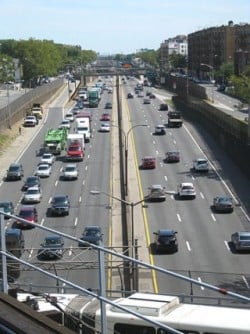Picture what it’s like living next to or very near a busy expressway, freeway, highway, motorway or turnpike for your entire life or if not that, then a goodly proportion of it. I would assume some of you reading this can directly relate. The sound of trucks barreling past all hours of the day and night is a sound with which I am intimately familiar.
You see, for part of my own life, I lived with my family in a house that abutted the Baltimore Beltway. At first I thought the prospect of the thoroughfare going in was great. I would get to see a lot of the construction activity, that is, on the portion of the project going in behind my home – I mean we’re talking the whole nine yards here – from the moment the work first commenced to the time said trucks and automobiles would initially roll past.

Today it’s a whole other story. People residing right by the expressway I would think are much better at putting two-and-two together than I was when I lived next to the Beltway.
That said, Los Angeles is taking proactive steps it seems to better protect the health of those citizens whose residences are neighboring freeways in the area. In fact, there was a story that laid this out in the Aug. 8, 2017 Los Angeles Times.
In the article, Times reporter Tony Barboza had explained that the Los Angeles City Council in 2016 established a rule regarding what he refers to as “special filtration” as it has to do with residential development built next to or very near sources of pollution from traffic.
An illustration accompanying the article from the South Coast Air Quality Management District and the City of Los Angeles shows an air filter – presumably the “special filtration” device alluded to by Barboza.
While the filter, again presumably, would not remove toxic gases, it would be effective at limiting some of the particulate matter pollution emitted from vehicles.
What’s surprising though is the number of residences in recent years that have been approved for construction near freeways in the Los Angeles region and in other parts of the state. According to Barboza, these number in the thousands.
The science is clear: tied to pollution from the motor vehicle traffic sector are conditions like asthma, bronchitis, chronic obstructive pulmonary disease, ischaemic heart disease, stroke, cancer among others. (For more perspective, see: “Putting into context air-pollution-statistical ‘estimates’” here.
So, why the continued issuing of residential building permitting for homes located adjacent to freeways is puzzling.
Some are wondering, meanwhile, how effective such air-filter-equipped homes are at trapping particles – including me. For an estimated 600,000 people (as determined via an analysis by the Times of 2010 census data, according to the L.A. Times reporter) whose residences are located 1,000 feet from an L.A.-area freeway or less the “special filtration” rule doesn’t apply. On the other hand, the ones that are directly affected by the Los Angeles air-filtration rule are new dwellings located inside of 1,000 feet of an area freeway.
Which leaves a lot of unanswered questions.
Based on my experience of living near a highway and knowing what I know about the dangers linked to emitted pollutants from vehicles transiting said infrastructure, I don’t understand why anyone would make a conscious choice to move next to or very near a busy freeway.
And, for the record, our family moved out of the house next to the Baltimore Beltway because my mom and dad just felt it was time to move. I doubt it had anything to do with freeway generated pollution.
For more on fine particulate matter and how it relates to early mortality and morbidity, see: “Can PM 2.5 lead to early mortality” here.
Note: article updated on Aug. 11, 2017 at 7:21 a.m. Pacific Daylight Time.
Image at bottom: Clean Air Revival
– Alan Kandel

Thanks for this article about houses along the highway and the air pollution problems indoors, not just outdoors. Here is an article about other kinds of indoor air pollution problems: http://www.pollutionairmask.com/sources-of-air-pollution-inside-your-home/